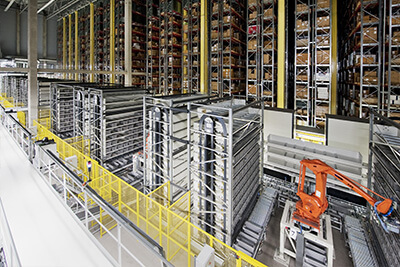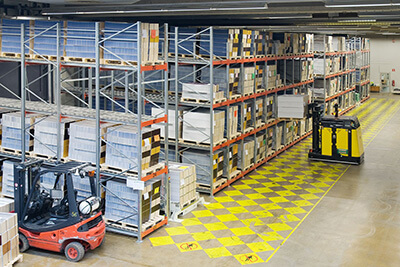One way to improve warehouse processes and operations is using the ABC method of inventory analysis, as it is a proven methodology of warehouse inventory management and will reap rewards in terms of cost savings and efficiency.
What is ABC inventory management?

Running an efficient warehouse means keeping the travel time of your operators or automatic equipment (such as conveyors, cranes or robots) to a minimum. The further each item or person must travel increases the time taken, and impacts the efficiency of the operation.
Whether your warehouse is manual, semi-automated or fully automated, travelling distance and time are just as significant.
On average, travelling time for workers or picking robots makes up 60 per cent of their working day, so by storing the right goods in the right place you can keep travelling time to a minimum.
 Broadly, you should keep frequently picked products in easy-to-access places near to the dispatch area. Less popular products can be kept in less accessible places. The way to work out what you should keep where is by using ABC analysis.
Broadly, you should keep frequently picked products in easy-to-access places near to the dispatch area. Less popular products can be kept in less accessible places. The way to work out what you should keep where is by using ABC analysis.
The method is derived from the 80/20 rule or Pareto Principle, which states that 80% of outcomes arise from 20% of all causes for any given event.
In warehousing, here’s how ABC inventory analysis works:
- A is for products accounting for around 80% of your warehouse movement, but take up about 20% of stock
- B is for products that account for 15% movement, and around 30% of stock
- C is for products with only 5% warehouse movement, but 50% of stock
 You then need to go about the process of categorising your stock. Here, you could opt for one of four methods:
You then need to go about the process of categorising your stock. Here, you could opt for one of four methods:
- By rotation – with this system, the stock rotated most frequently, and therefore in highest demand is categorised as ‘A’, with the least frequently rotated as ‘C.’
- By unit cost – this is useful tool for businesses with widely varying costs. High cost products will be ‘A’; lowest cost products will be ‘C’.
- By total inventory value – here, the total value of the stock is considered, rather than the unit value. Again, the highest value in total is ‘A’; the lowest value is ‘C’.
- By use and value combined – this is the most comprehensive system to use, and one applied in many warehouses. ‘A’ category products will be both in high demand and have a high value; the opposite will be true of those in category ‘C’.
 Using the ABC method, you then categorise your range of products into A, B or C. You may even find you need to do this on a smaller scale for different areas of the warehouse.
Using the ABC method, you then categorise your range of products into A, B or C. You may even find you need to do this on a smaller scale for different areas of the warehouse.
Once you have the information to hand, the warehouse can be arranged accordingly, and regions within the warehouse can be classified into A, B and C. ‘A’ products go into an easily accessible area, where you might need to pick full pallets; ‘B’ products go into an area where you pick smaller quantities; and ‘C’ products are housed where you don’t need frequent, easy, speedy access.
With the warehouse areas and products categorised, you then rearrange the warehouse accordingly and you should soon see the benefits in terms of efficiency.
Five benefits of using ABC inventory control

- By reorganising and streamlining the warehouse process in this way, the operation will be more efficient
- Stock control will be improved - high demand items are easily accessible
- Reduced costs, associated with improved inventory management, by avoiding overstocking (and reducing the risk of items going out of stock).
- Speed of processing - operators or automated equipment spend less time on travelling
- Improved options for storage.
Storage using the ABC inventory system
 With a well organised warehouse, it is far easier to properly equip each area with pallet racking and shelving appropriate to the products and their speed of turnaround.
With a well organised warehouse, it is far easier to properly equip each area with pallet racking and shelving appropriate to the products and their speed of turnaround.
Once the products in each category are identified, the next step is to actually implement the ABC inventory system. If done correctly, this will considerably contribute to your warehousing solution optimisation.
We are leading designers, manufacturers and suppliers of warehousing and distribution centre storage solutions and can advise on the most suitable for your warehouse. To find out more, please get in touch with the team.